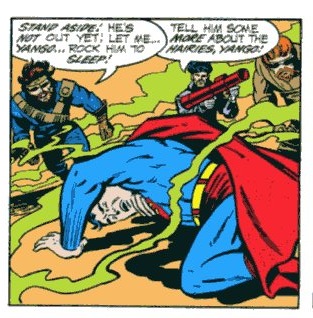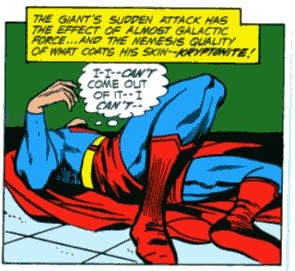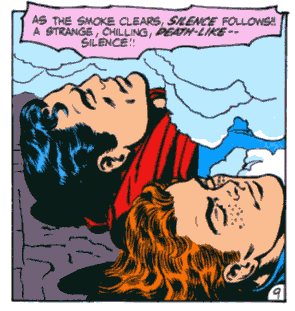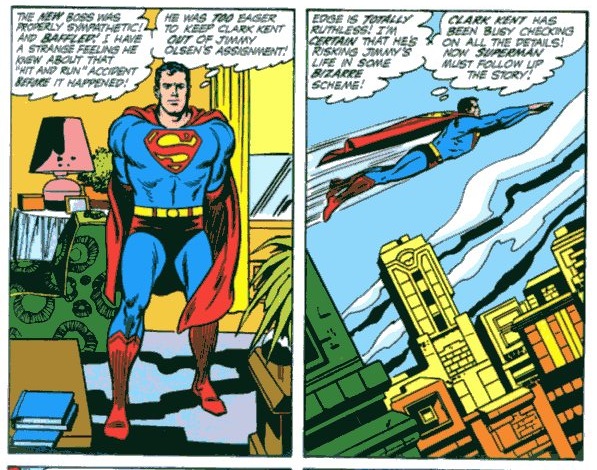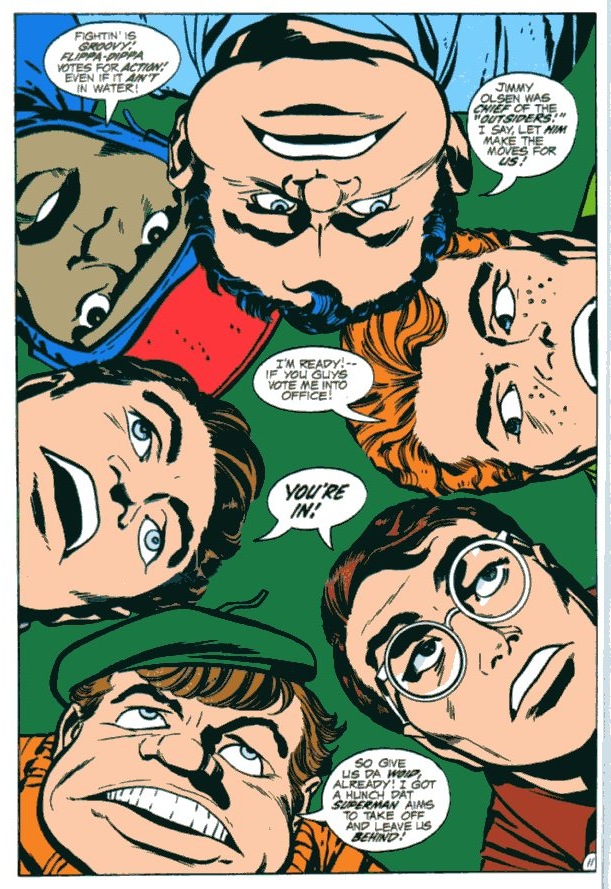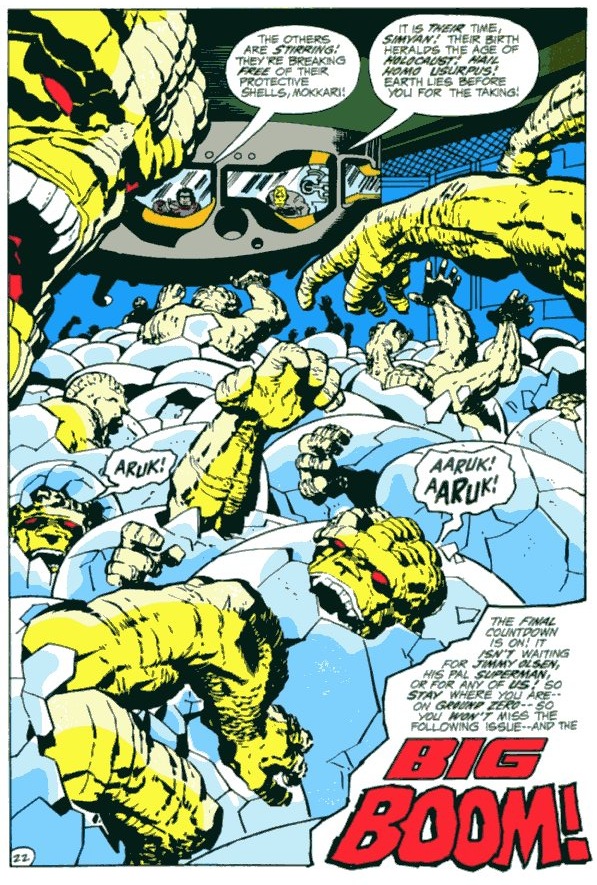Superman…unconscious?!
Kirby fans often note that his comics are bursting with ideas. And, after reading DC’s two volume 2003 collections of Kirby’s run on Jimmy Olsen, I can’t deny it. Lots and lots of stuff happens in these stories. There’s secret underground hippie biker lost realms, secret government clone projects, green Jimmy Olsen clones, scrappy fighting kids, miniature clones of scrappy fighting kids, gratuitous Scottish accents, extradimensional evil, extradimensional good, alternate versions of Don Rickles, tiny worlds populated by even tinier monster movie rejects,groovy hippie pads, loch ness monsters, evil tycoons, evil mad scientists, and and lord knows what else. Just about every page has enough plot points to keep a typical contemporary comic happy for a year.
And yet. All those ideas, all that frantic creativity — you read one page and it’s charming; you read two pages and it’s impressive — you read a whole comics worth, though, and it starts to get wearisome. Kirby’s stereo has one volume, and that volume is everything plus the kitchen sink plus a four-armed monster and an atomic explosion. Occasionally he throws in schticky banter, not so much as a break from the noise as to make you wish the noise would come back and the banterers would shut the fuck up. And then (mercifully or not) the plot’s back, racing, racing, racing to nowhere in particular.
Superman…unconscious?!
Because, the sad truth is that, for all of Kirby’s ideas, not a one of them goes anywhere or builds to anything or does anything except sit there saying, “Ayup! Here’s an idea!” The result is that, for all the wild rushing and hand waving (literally with the four-armed monster(!!!!)) these books are incredibly, deafeningly tedious and repetitive. Protagonists are beset by antagonist, protagonists are knocked unconscious/otherwise immobilized; protagonists come back and beat antagonists (or occasionally realize that antagonists are good guys.) Repeat. Repeat. Repeat. It goes on and on, remorselessly, through more than 300 pages. Plot development, characterization, a point of any kind — forget it. Fight, setback, victory, fight, setback, victory. Epic.
Superman and Jimmy Olsen…unconscious?!
People often talk about the cosmic scale of Kirby’s comics. Maybe that’s true in some of his other work, but here the cosmic touches look suspiciously like the stupidest kind of fantasy/sci-fi cliches. Evil vs. good; dark vs. light. You can tell the bad guys because they say, “We’re bad guys!” and blow things up, whereas the good guys say “We’re good guys!” and blow things up. Also the good guys banter and the bad guys rant. The ranting is more fun than the banter, but not sufficiently more fun for me to care enough to root for one side or the other.
Marston/Peter were devoted to feminism and fetish; they had a ideological backdrop which informed and gave resonance to their nutty ideas. Bob Haney had a bizarrely idiosyncratic grasp on genre and the holes in genre which made his ideas stumble and bump against each other in a series of pratfalls which were both unexpected and meaningful. But Kirby, at least in the Jimmy Olsen series, has no ideological commitments to speak of, and when he uses genre — as in his use of vampires or werewolves — it’s carefully compartmentalized. The vampires and werewolves are from another world; Jimmy and Supes fight them and eventually help them, but they never really themselves end up in a horror story. Instead they fight, experience setbacks, and then attain victory.
I know what I’m really supposed to like in Kirby is the art. I’ve never really fallen in love with his work, but there are definitely moments here I enjoy. Here for intance:
In the left panel, everything’s blocky and off, even Superman himself. The pose, with arms behind him, makes his silhouette seem off; and even the S on his chest seems squashed and askew. In the right panel, the cityscape is tilted and odd; it looks like a lego city built on an incline. Both images have an odd, lumpiness — a material forcefulness that is not so much contradicted by, as built upon, their imperfections.
And, of course, this is hard to resist:
In this power-packed issue — we look up the newsboy legions’ noses!
So, yes, I can appreciate that to some extent. And maybe the real way to enjoy these issues is not to read them at all, but just to flip through looking for those goofy Kirby monsters or enjoyably odd perspectives. But I did unfortunately read the thing…and having done so, I”m afraid Kirby’s art, enjoyable as it often is, doesn’t repay me for the couple of hours flushed down the drain. The power of the art, indeed, starts to veer towards self-parody; it seems to be relentlessly trying to convince you that something interesting is happening, to make up for the utter lack, not of ideas per se, but of ideas that have any meaning or consequence. Kirby ends up sounding like one of his typical monstrous creations, screaming “Aaruk! Aaruk!” It’s loud and has an initial novelty, but it doesn’t exactly fill me with admiration for the critter’s volcanic creativity.

